MSI Ti4200-TD8X64
Benchmarks & Performance:
Our Test System:
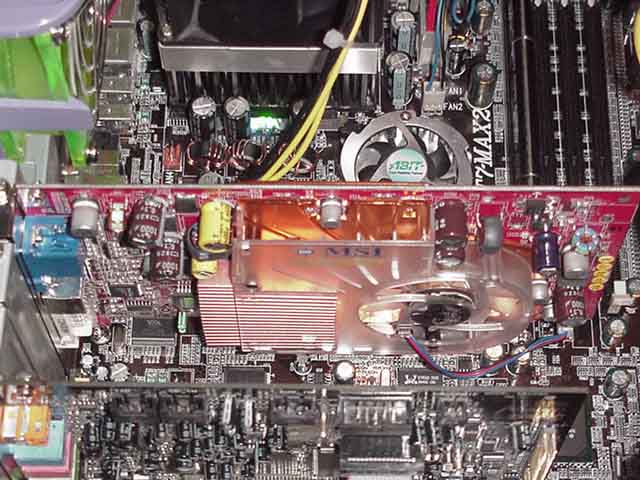
- AMD Athlon XP 1600+ (AGOIA stepping)
- ABIT AT7-MAX2 (Enhanced settings enabled in BIOS)
- Alpha PAL 8045 w/80cfm Delta (Air Cooled)
- 256mb Corsair XMS 3500 and 512mb Corsair XMS 3200C2 (2-2-2, 1T, enhanced)
- Western Digital 30Gb ATA 100 7,200rpm
- Soundblaster Audigy X-Gamer
- Antec True Power 430W Power Supply
- ViewSonic E90fb Monitor
Video Cards:
- Albatron Ti4200P Turbo 128mb (4x AGP)
- ABIT Ti4200 OTES 64mb (4x AGP)
- MSI Ti4200-TD8X64 64mb (8x AGP)
- MSI Ti4200-VTD64 64mb (4x AGP)
Testing Procedure:
All testing was done on a fresh install of Windows XP Professional build 2600. All benchmarks were completed on the desktop with no other software programs running. For overclocking the videocards, we used the built-in overclocking feature that is included with the Nvidia 40.72 drivers. We were also using VIA Hyperion version 4.45 4in1 drivers. Our testing processor was running unlocked at 166FSB and a 10.5 multiplyer giving us a grand total of 1.75ghz. During this review, the room temperature was 22 degrees Celsius, while the case temperature was 25 degrees Celsius.
FutureMark; 3dmark2001 Second Edition, Build 330:
3DMark2001SE build 330 is the latest installment in the 3DMark series by FutureMark. By combining DirectX8 support with completely new graphics, it continues to provide good overall system benchmarks. 3DMark2001SE build 330 was created in cooperation with the major 3D accelerator and processor manufacturers to provide a reliable set of diagnostic tools. It demonstrates 3D gaming performance by using real-world gaming technology to test a system’s true performance abilities. All tests were run at 1024×768 at 32 bit color and then again including 4x AA.
The first chart shows the results without AA.
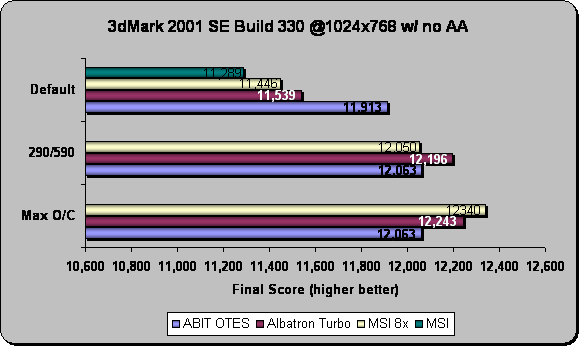
This second chart shows the results using 4x AA.
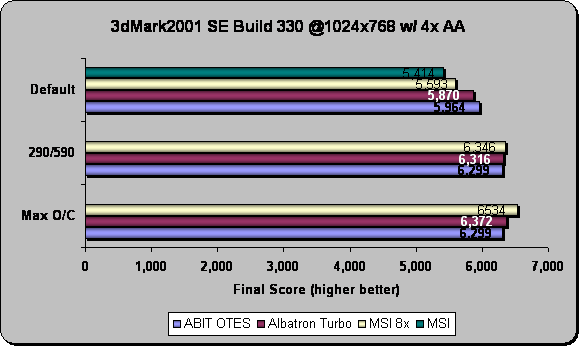
Results: 3dMark2001SE build 330 shows that ABIT OTES is the fastest at default clock speeds, which makes perfect sense, because the ABIT has a faster 275mhz core speed. Although by running the cards at indentical 290mhz core and 590mhz memory speeds, the MSI 8x was able to out-perform both 4x cards running both 64mb and 128mb of memory.
Nvidia; Chameleon Mark:
Chameleon Mark is not a brand new benchmarking utility, but it still shows a video card’s true capabilities. This benchmark is based upon the popular “Chameleon” demo released by Nvidia with the introduction of the GeForce3 line of GPUs. Chameleon Mark is primarily used to measure pixel shader performance for a variety of shaders. Let’s see how the Albatron performs against the other cards in Chameleon Mark at 1024×768 with the 40.72 drivers:
The first graph is with all three of our test cards at their default settings.
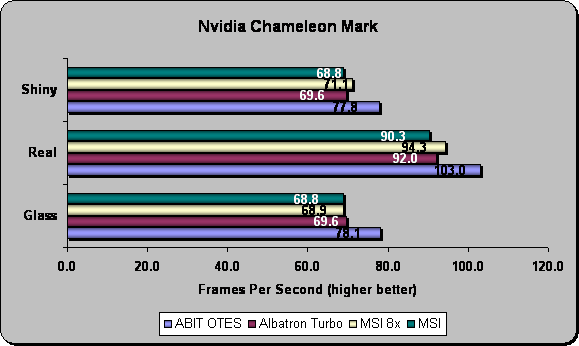
The next graph looks at how the ABIT OTES and the Albatron do while overclocked.
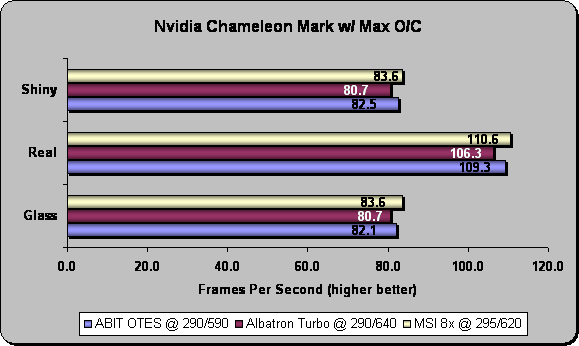
Results: Again due to the default speeds, the ABIT OTES easily surpasses the others. Although when overclocked to each cards’ limit the MSI 8x takes the gold, but not by that much over the ABIT OTES.
NovaLogic; Comanche 4:
The Comanche 4 benchmark demo is a unique benchmark as it represents a real-world gaming experience. It contains the single player Eagle’s Talon mission from the game as well as a detailed cinematic. This DirectX 8.1 benchmark demo measures your system’s performance in the standard frames per second format. On this benchmark, we tested our cards at 1024×768 x 32-bit and the audio turned off.
The first graph is with all three of our test cards without AA.
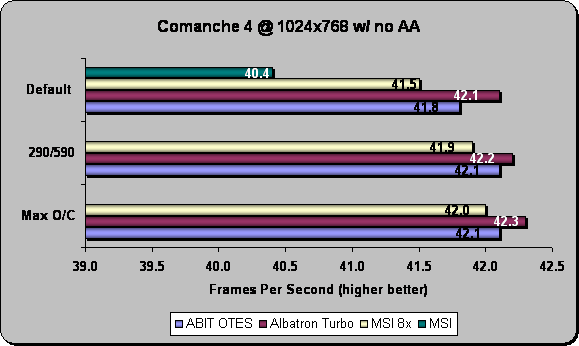
The next graph shows our results using 4x AA to put even more strain on the cards.
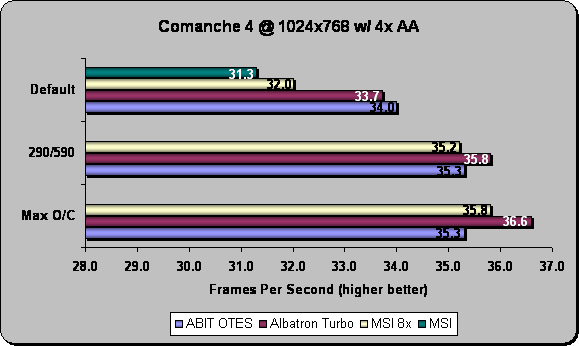
Results: We have found that the 128mb Albatron Turbo runs good on this benchmark as it tends to benefit those cards that have 128mb of memory. Although the MSI 8x does not come in first place, it still has a strong standing and great performance to our two leading Ti-4200 cards.
CodeCult; Code Creatures Pro:
The Codecreatures benchmark is written with Microsoft’s DirectX 8.1 API and incorporates the use of Vertex and Pixel Shaders popular on next generation 3D accelerators. The benchmark plays a photo-realistic nature scene and calculates the performance of the graphics adapter by measuring the FPS that it can display at 1024×768, 1280×1024 and 1600×1200 resolutions. The score is a geometric mean of those three resolutions called the Codecreatures number. Although, for this review we tested tested our cards at 1024×768 x 32-bit with the sound disabled. We also changed our memory to a 512mb stick of Corsair PC-3200C2 since 512mb of memory is needed for this benchmark.
The first graph is with all three of our test cards without AA.

The next graph shows our results using 4x AA to put even more strain on the cards.
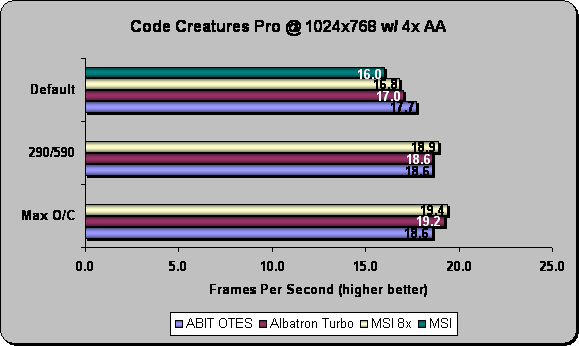
Results: I really love this benchmark because it tends to push the cards harder than any other benchmark I use. I also feel that this benchmark is one of the future, since pixel shading and graphics seem to be going in this direction. Once again the MSI 8x card is able to take the lead or tie for the lead when overclocked.
That concludes our benchmarks we chose to do on our MSI Ti-4200-TD8X64 video card. Let’s go on and see our final thoughts on the card.

Comments are closed.